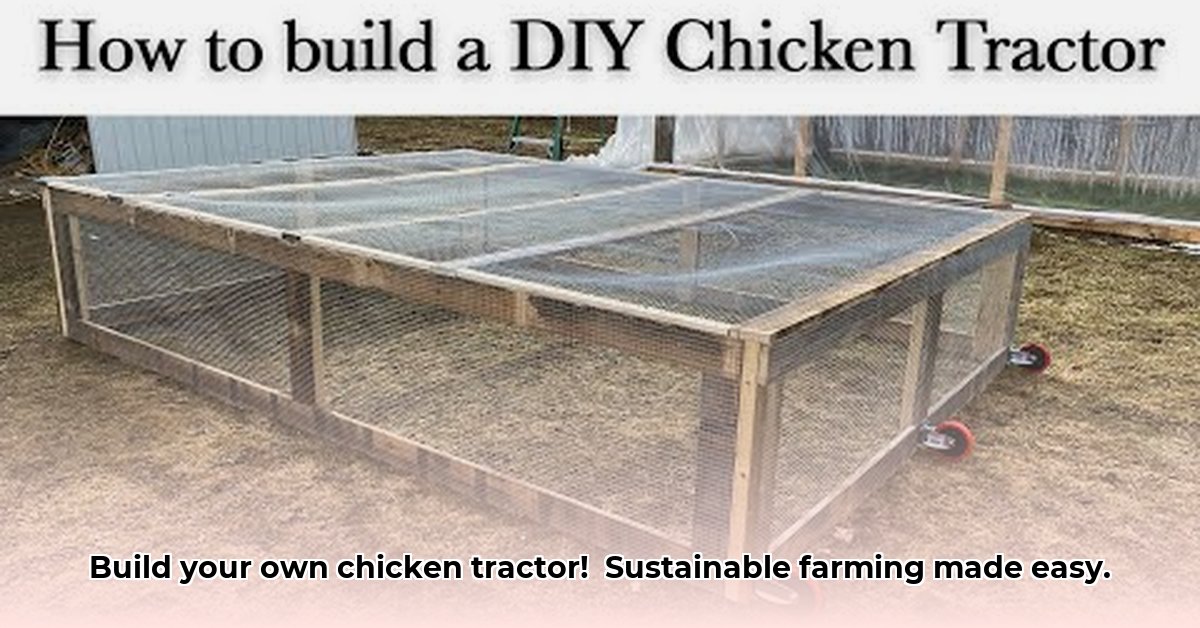
Chicken Tractor Build: Your Guide to Happy, Healthy Hens
Ready to build your own mobile chicken coop? Building a chicken tractor is a rewarding project that benefits your hens and simplifies sustainable farming practices. This guide provides a step-by-step process, making it suitable for both beginners and experienced DIYers. For additional nesting box ideas, check out this helpful resource: nesting box designs.
Designing Your Dream Chicken Tractor: Planning for Success
Before starting, plan carefully. Consider your flock size (more hens require a larger tractor), your yard's terrain (bumpy terrain necessitates sturdier wheels), and draw a simple design. Keep it straightforward for your first build; you can add features later. What size flock are you planning for? This directly impacts the chicken tractor's dimensions.
Gathering Your Supplies: The Chicken Tractor Shopping List
Choosing quality materials ensures a durable and safe chicken tractor. Pressure-treated lumber offers longevity and weather resistance. Crucially, use hardware cloth (stronger than chicken wire) to protect your hens from predators. Don't forget heavy-duty wheels for easy movement!
| Material | Quantity (Example) | Notes |
|---|---|---|
| Treated Lumber | 20 2x4s (adjust as needed) | 2x4s offer a good balance of strength and ease of handling. |
| Hardware Cloth | 1 roll (enough to cover walls) | Choose a gauge sturdy enough to deter predators (e.g., 1/2-inch). |
| Plywood | 1 sheet (or more, depending on size) | Use exterior-grade plywood for weather resistance. |
| Wheels | 4 (heavy-duty) | Consider the finished tractor's weight and your terrain. |
| Hinges & Latches | As needed | Choose sturdy, weather-resistant options. |
| Screws & Nails | Plenty! | Use galvanized or exterior-grade fasteners. |
| Roofing Material | As needed | Metal roofing or asphalt shingles are good choices. |
Building Your Chicken Tractor: A Step-by-Step Guide
Let's build! This is the rewarding part. Take your time and don't hesitate to seek help if needed.
Building the Foundation: The Frame. Construct the main frame using your treated lumber. Ensure it's square and sturdy. Use a level to check for evenness. Pre-drilling holes prevents wood splitting when screwing.
Protecting Your Flock: Attaching the Walls. Securely attach the hardware cloth to the frame. This is key to predator protection; ensure it's tight. Overlap edges and fasten securely with staples or wire ties in addition to screws.
Creating a Cozy Floor: Installing the Floor. Cut and attach the plywood flooring to keep bedding clean and dry. A slight incline aids drainage.
Adding Mobility: Attaching the Wheels. Attach the wheels securely to the frame's bottom. Well-placed wheels ease movement. Ensure the wheels are rated for the finished tractor's weight.
Easy Access: Installing Doors and Access Points. Build and attach doors for easy access to clean and feed your hens. Use sturdy hinges and latches for security.
Staying Dry and Safe: Adding a Roof. A roof protects from sun and rain. Use plywood, metal sheeting, or asphalt shingles.
The Finishing Touches. Caulk gaps and cracks to prevent drafts and unwanted critters. Check that everything is secure and weatherproof.
Weighing the Pros and Cons: Is a Chicken Tractor Right for You?
Considering the advantages and disadvantages helps determine if a chicken tractor suits your needs. Is the increased labor for moving the coop worth the benefits of improved pasture health and reduced parasite burdens?
| Advantages | Disadvantages |
|---|---|
| Fresh pasture for hens | Requires regular moving (daily is ideal) |
| Reduced feed costs | Initial time investment to build |
| Natural pest control | Potential for predation (if not built securely) |
| Improved hen health and happiness | Weather dependent; may need adjustments |
| Easier cleaning than a stationary coop | Ongoing maintenance (minor repairs etc.) |
| Great for small spaces or rented properties | Might need adjustments for severe weather |
Building your own chicken tractor is both enjoyable and beneficial. Remember responsible chicken keeping practices: regular cleaning, fresh water, and health monitoring. Enjoy your sustainable mobile chicken-keeping solution! Have you considered the long-term cost savings associated with reduced feed bills and improved hen health?
How to Design a Mobile Chicken Coop for Optimal Pasture Rotation and Pest Control
Key Takeaways:
- Mobile chicken coops improve pasture health through rotational grazing.
- Moving the coop reduces parasite and pest pressure.
- Chicken manure acts as natural fertilizer, enriching the soil.
Designing Your Mobile Chicken Coop: A Step-by-Step Guide
This isn't just a coop; it's a sustainable farming solution!
Step 1: Size and Design Considerations. Determine the number of hens (4 square feet per hen) and the coop's portability (daily or weekly movement). Draw a blueprint.
Step 2: Materials Selection. Choose weather-resistant lumber, plywood, and hardware cloth.
Step 3: Construction – Building the Mobile Base. Use heavy-duty casters and a sturdy lumber frame.
Step 4: Assembling the Coop Structure. Build walls, roof, and integrate roosting bars and nesting boxes. Ensure adequate ventilation.
Step 5: Incorporating Run and Fencing. Construct a secure run using sturdy wire mesh or hardware cloth.
Step 6: Implementing Pasture Rotation. Plan a rotation strategy to prevent overgrazing and allow soil regeneration.
Step 7: Pest Control Strategies. Regular cleaning minimizes infestation risks. Keep the area clean and free of debris.
Pros and Cons of Mobile Chicken Coops
| Feature | Pros | Cons |
|---|---|---|
| Pasture Management | Improved pasture health; reduced overgrazing; natural fertilization. | Requires planning and regular coop relocation. |
| Pest & Parasite Control | Reduced pest and parasite burden; healthier chickens. | Requires diligent cleaning and maintenance. |
| Soil Health | Enhanced soil fertility via natural manure distribution. | Potential for localized nutrient saturation if not managed properly. |
| Labor | Increased labor for coop relocation; opportunity for exercise! | Added time commitment compared to stationary coops. |
| Initial Investment | Can be higher upfront costs compared to stationary designs. | Significant investment only offset by long-term benefits. |